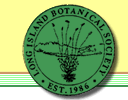Saturday, April 12, 2025, 11:00
AM
Manetto Hills Park, Plainview, Nassau Co.
Trip leader: Dave Taft
At this time of year, we will be on the lookout for several
emerging unusual plant species in the vicinity of this delightful woodland trail tucked between the Northern State Parkway and the LIE. Please register online with the North Shore Land Alliance (northshorelandalliance.org).
Joint trip with the North Shore Land Alliance
Saturday, May 17, 2025, 10:00
AM
Coffin Woods, Locust Valley, Nassau Co.
Trip leader: Al and Lois Lindberg
Veteran Long Island naturalists Al and Lois will guide us through this North Shore Wildlife Sanctuary property in the season of spring ephemeral wildflowers, when we expect the preserve’s stunning red Trillium flowers will make an appearance. Please register online with the North
Shore Land Alliance
northshorelandalliance.org).
Joint trip with the North Shore Land Alliance
Saturday, September 27, 2025, 10:00 AM–4:00 PM
Montauk Point State Park, Suffolk Co.
Trip leader:
Trip leader: Vicki Bustamante
Tides permitting, we will first look for signs off the point of the ancient “Ghost Forest” (see 2011 LIBS newsletter, Vol. 21, No. 4) and the 4,700 year old Atlantic White Cedar stumps and remnant peat bog. We will then botanize a few small coastal plain ponds, and then continue on to a coastal salt pond (Oyster Pond) while passing through maritime dunes, beach, shrubland, and woodlands.
Some expected rarities include Eupatorium torreyanum, Juncus brachycarpus, Asclepias incarnata var. pulchra, Elymus glabriflorus var. glabriflorus, Euphorbia polygonifolia, Polygonum glaucum, Schoenoplectiella purshiana var. purshiana, Aristida geniculata, Atriplex glabriuscula, Viburnum dentatum var. venosum, Sesuvium maritimum, Glyceria obtusa, and Juncus dichotomus.
Hike will be 5 miles or so but easy walking. Bring water, lunch, snacks and insect protection. Sturdy walking shoes/boots, preferably waterproof, as we will be navigating through some wet areas and puddles and shoreline, walking sticks, binocular, water, and snack (or lunch), tick protection.
Register online at the New York Flora Association website (montauk@nyflora.org) and additional details regarding the trip will be sent in your confirmation email. Field trip is limited to 20 participants.
Joint trip with the New York Flora Association
Saturday, December 6, 2025, 11:00 AM
Hither Hills State Park, Montauk, Suffolk Co.
Trip leader: Vicki Bustamante
Vicki will lead participants through an enchanted maritime forest, with its twisted oaks and crooked pitch pine trees, in the Walking Dunes. Please register online with the North
Shore Land Alliance
northshorelandalliance.org).
Joint trip with the North Shore Land Alliance















